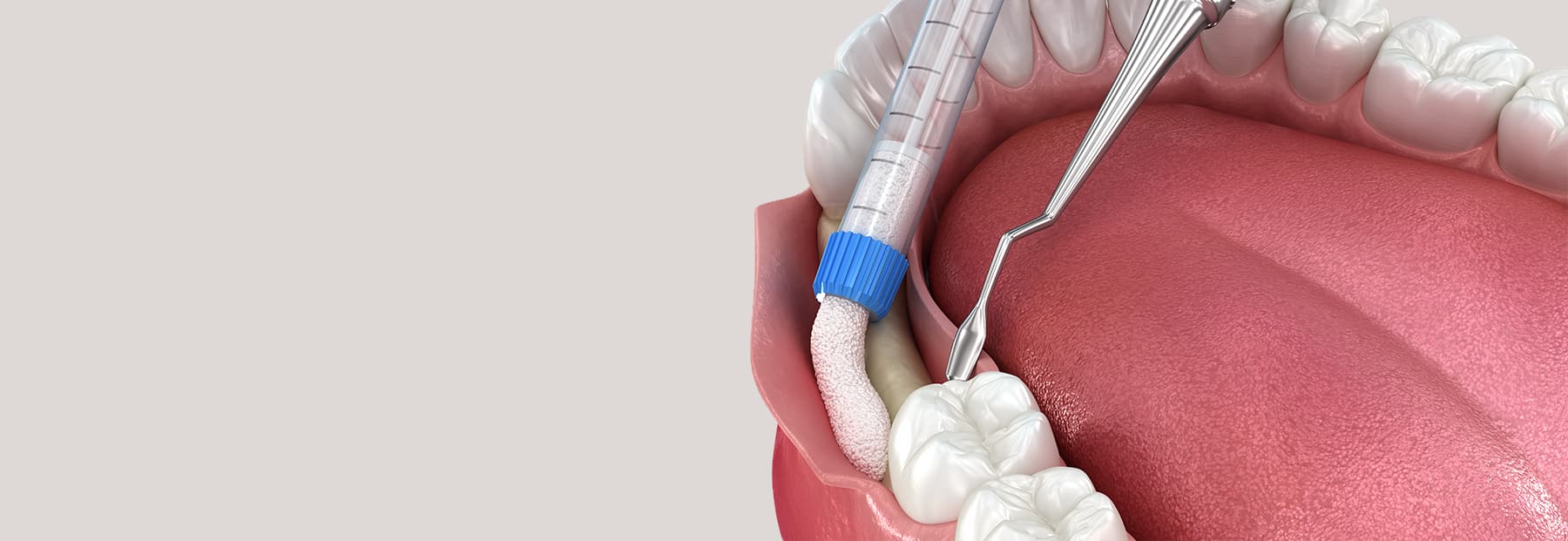
Bone Grafting
At Leading Edge Oral Surgery, our specialized team utilizes advanced techniques and high-quality materials to ensure effective bone regeneration and support. Whether you require bone grafting for dental implants or other needs, our commitment to precision and patient care ensures you receive the best possible outcomes for your oral health journey.
About Bone Grafting
Bone grafting involves transplanting bone to restore areas with insufficient bone mass. This procedure can replace missing bone and stimulate new bone growth, providing a stable foundation for dental implants.

Dr. Craig Levine
Oral & Maxillofacial Surgeon
“Bone grafting is a routine procedure that helps restore and strengthen jawbone structure. By addressing bone loss, we enable patients to consider dental implants as a viable option for achieving optimal oral health and functional restoration.”
When is Bone Grafting Needed?
You may need bone grafting if you have lost bone due to:
- Advanced Gum Disease: Chronic infections can erode jawbone.
- Trauma or Injury: Accidents can damage bone structure.
- Chronic Tooth Loss: Long-term missing teeth can lead to bone resorption.
Bone loss can affect your oral function, facial shape, and your eligibility for implants. However, advanced bone grafting techniques can rebuild and regrow bone, making implants possible.
Causes of Jawbone Loss and Deterioration
The following are the most common causes for jawbone deterioration and loss that may require a bone grafting procedure:
- Tooth Extractions: The rate that the bone deteriorates, as well as the amount of bone loss that occurs, varies greatly among individuals. However, most loss occurs within the first eighteen months following the extraction and will continue gradually throughout your life.
- Periodontal Diseases: Periodontal diseases are ongoing infections of the gums that gradually destroy the support of your natural teeth. Periodontal disease often affects one or more of the periodontal tissues: alveolar bone, periodontal ligament, cementum, or gingiva.
- Dentures/Bridgework: Unanchored dentures are placed on top of the gum line, but they do not provide any direct stimulation to the underlying alveolar bone. With bridgework, the teeth on either side of the appliance provide sufficient stimulation to the bone, but the portion of the bridge that spans the gap where the teeth are missing receives no direct stimulation. Over time the lack of stimulation causes the bone to resorb and deteriorate.
Advanced Bone Grafting Procedures
We perform several bone grafting procedures designed to stabilize and replenish lost bone in various areas within the mouth.
Ridge Augmentation
We use this technique to restore the height and width of bone lost in the jaw. This recreates natural contour in the arch and increases available bone for implant support.
Ridge Preservation (aka Socket Preservation)
Following a tooth extraction, ridge preservation, or socket preservation, adds bone grafting material directly to hollowed-out tooth sockets, preventing the bone from collapsing and preserving the site for future implant placement.
Sinus Lift
Performed to enable implant placement in upper premolar and molar areas, a sinus lift gently elevates the floor of the maxillary sinus cavity. Bone grafting material is then added to or beneath the sinus floor, increasing the height of bone necessary for implant placement.
What technology is used for bone grafting?
Our surgeons use pre-surgical 3-D Bone Graft Planning to generate predictable, successful bone grafting results. We place a titanium mesh barrier over bone grafting materials, which aids in maintaining the shape of the jawbone and gum tissue as new tissue grows and integrates with existing bone. PIEZOSURGERY®, a minimally invasive ultrasonic technique, allows our doctors to perform bone grafting procedures without causing trauma to surrounding soft tissues.
Recovery and Aftercare
Post-surgery, patients can expect:
- Pain Management: Medications to manage discomfort.
- Activity Restrictions: Limited physical activity to ensure proper healing.
- Follow-Up Visits: Regular check-ups to monitor the graft’s progress and integration
Why Choose Leading Edge for Bone Grafting?
At Leading Edge Oral Surgery, we pride ourselves on our expertise in bone grafting procedures. Our team of skilled oral surgeons is dedicated to restoring jawbone structure with precision and care. We understand the importance of individualized treatment plans, tailored to each patient’s specific needs. During your consultation, we will thoroughly assess your condition, discuss treatment options, and create a personalized plan to achieve optimal results and restore your dental health.
Find one of our convenient locations
Contact Us
Fields marked with “*” are required.
"*" indicates required fields
